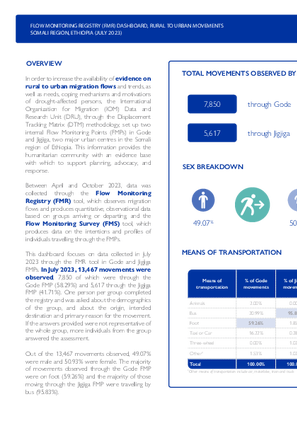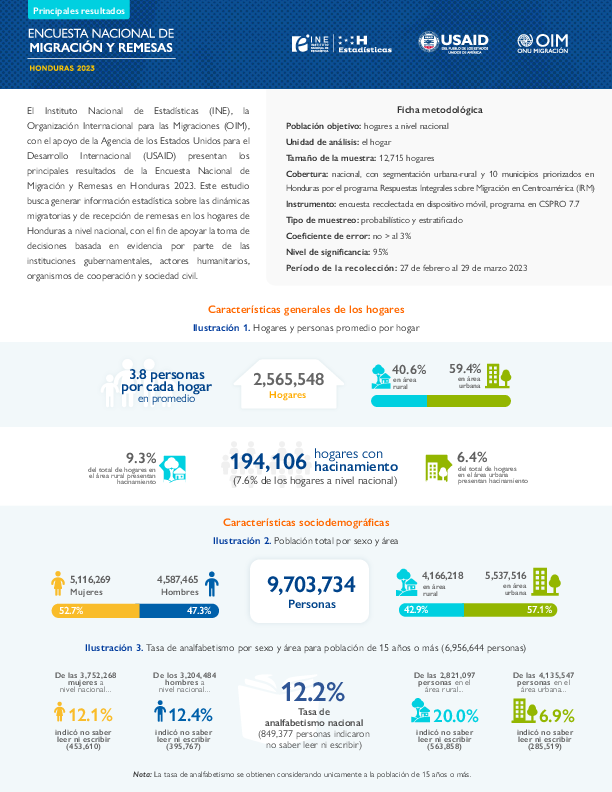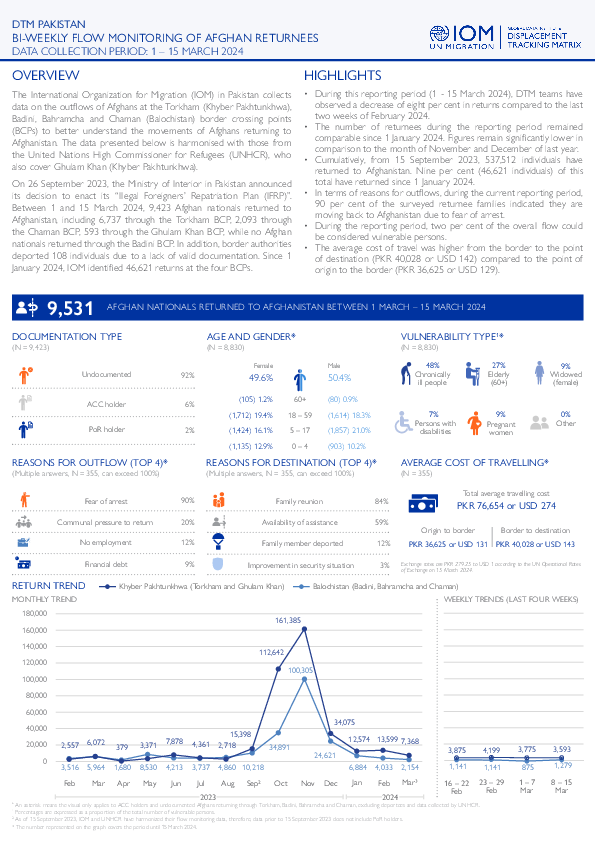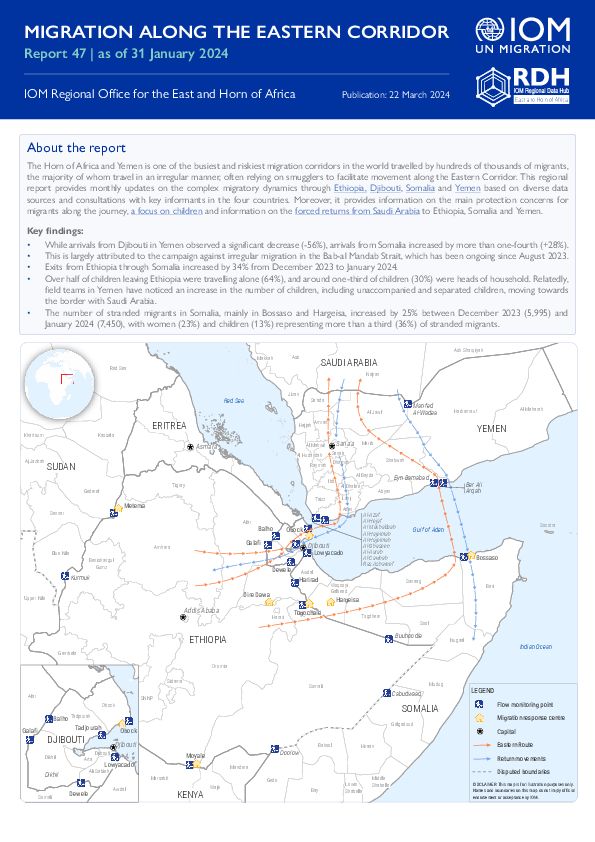-
Countries
-
Data and Analysis
-
Special Focus
-
Crisis Responses
Flow Monitoring
Domain host
migration.iom.int

Contact
DTM Ethiopia, DTMEthiopia@iom.int
Language
English
Location
Ethiopia
Period Covered
Jul 01 2023
Jul 31 2023
Activity
- Flow Monitoring
In order to increase the availability of evidence on rural to urban migration flows and trends, as well as needs, coping mechanisms and motivations of drought-affected persons, the International Organization for Migration (IOM) Data and Research Unit (DRU), through the Displacement Tracking Matrix (DTM) methodology, set up and piloted two internal Flow Monitoring Points (FMPs) in Gode and Jigjiga, two major urban centres in the Somali region of Ethiopia. The pilot ran from June 2023 through August 2023.
This dashboard focuses on data collected in July 2023 through the FMR tool in Gode and Jigjiga FMPs. In July 2023, 13,467 movements were observed, 7,850 of which were through the Gode FMP (58.29%) and 5,617 through the Jigjiga FMP (41.71%).

Contact
DTMAfghanistan@iom.int
Language
English
Location
Afghanistan
Period Covered
Mar 17 2024
Mar 23 2024
Activity
- Survey
- Flow Monitoring Survey
- Flow Monitoring
IOM Afghanistan's DTM Flow Monitoring activity, initiated at the beginning of 2024, seeks to quantify and better understand the mobility dynamics at Afghanistan’s borders. On 10 January 2024, DTM began deploying field teams at four border crossing points with the Islamic Republic of Iran (IRN) and Pakistan (PAK), expanding to another border crossing point Ghulam Khan as of 11 February (see map below for the locations of all five crossing points), to conduct two interlinked exercises. The first is a headcount of all individuals entering or leaving Afghanistan (including returnees), also called Flow Monitoring Counting (FMC), to gauge flow volume. The second is a survey of randomly selected Afghan national individuals or groups entering or leaving Afghanistan, also called the Flow Monitoring Survey (FMS), to understand the profiles, motivations, and vulnerabilities of the target population. This snapshot provides key findings combining various IOM data sources, including DTM Afghanistan’s FMC and FMS activities, DTM Pakistan’s Flow Monitoring of Afghan returnees, and IOM Afghanistan’s Cross-Border Post-Arrival Humanitarian Assistance (CB-PAHA) program, for the period 17 to 23 March 2024. For more information about methodology, see the section in the last page of this report titled “IOM INFLOW DATA.”

Contact
iomkyrgyzstan@iom.int
Language
English
Location
Kyrgyzstan
Period Covered
Dec 01 2023
Dec 31 2023
Activity
- Survey
- Flow Monitoring Survey
- Mobility Tracking
- Baseline Assessment
The report presents findings from key informant interviews and surveys conducted in Kyrgyzstan using the International Organization for Migration's (IOM) Mobility Tracking Matrix (MTM) system. Adapted from IOM's Global Displacement Tracking Matrix (DTM) methodology, MTM aims to collect and analyze data to understand the mobility, vulnerabilities, and needs of displaced and mobile populations for evidence-based migration management.
The study utilized DTM's Mobility Tracking Baseline Assessment and Survey methods. Key informant interviews, conducted with local representatives knowledgeable about migrant situations and mobility, provided insights into the timing, locations, and reasons for migrant worker returns. Surveys were administered to returning migrant workers, covering socio-economic profiles, migration experiences, employment, remittances, general well-being in Kyrgyzstan, and impacts of imposed sanctions.

Contact
iomtegucigalpa@iom.int
Language
Spanish
Location
Honduras
Period Covered
Feb 27 2023
Mar 29 2023
Activity
- Survey
El Instituto Nacional de Estadísticas (INE), la Organización Internacional para las Migraciones (OIM), con el apoyo de la Agencia de los Estados Unidos para el Desarrollo Internacional (USAID) presentan los principales resultados de la Encuesta Nacional de Migración y Remesas en Honduras 2023. Este estudio busca generar información estadística sobre las dinámicas migratorias y de recepción de remesas en los hogares de Honduras a nivel nacional, con el n de apoyar la toma de decisiones basada en evidencia por parte de las instituciones gubernamentales, actores humanitarios, organismos de cooperación y sociedad civil.

Contact
DTM Ethiopia, DTMEthiopia@iom.int
Language
English
Location
Ethiopia
Period Covered
Jan 01 2024
Jan 31 2024
Activity
- Flow Monitoring
In January 2024, a total of 40,464 movements were observed across the six flow monitoring points (FMPs) in Ethiopia. This represents a 5.7% increase in daily average movements in comparison with December 2023 when an average of 1,235 movements per day were observed.
Outgoing movements (63%) during January decreased while incoming movements (37%) increased compared to the previous month, mainly due to increased incoming flows of returning migrants to Ethiopia through different entry points. A total of 25,373 outgoing movements were observed, out of which 12,558 (49.5%) were heading to Saudi Arabia, 5,404 (21.3%) were going to Kenya, 2,182 (8.6%) to Djibouti, 1,682 (6.6%) to Somalia, 1,005 (4%) to South Africa, 954 (3.8%) to Yemen, and 552 (2.2%) to Sudan, while remaining movements were heading to other Southern African, Middle Eastern, and North American countries.
At the same time, 15,091 incoming movements were observed, out of which 10,401 (68.9%) originated from Sudan, while 2,291 (15.2%) came from Kenya, 1,392 (9.2%) from Djibouti, 882 (5.8%) from Somalia and 125 (0.9%) came from other Middle Eastern and Horn of Africa countries. Most incoming movements were by Ethiopians (65.3%), followed by Sudanese nationals (33.5%). Returning Ethiopians departed from Sudan (52.7%), Kenya (23.1%), Djibouti (14%), Somalia (8.9%), Yemen (1.2%), and South Sudan (0.1%).

Contact
iomtegucigalpa@iom.int
Language
Spanish
Location
Honduras
Period Covered
Feb 27 2023
Mar 29 2023
Activity
- Survey
Honduras cuenta con un historial de distintas dinámicas migratorias. En los últimos tres años scales (de octubre 2020 a septiembre 2023), se contabilizan más de 746,000 aprehensiones de personas hondureñas en la frontera suroeste terrestre de Estados Unidos (CBP). Asimismo, más de 768,000 personas nacidas en Honduras residen en Estados Unidos (US Census Bureau). Por otro lado, las remesas familiares son un importante elemento de la economía y las familias en Honduras. Durante 2022, se recibieron 8,686.2 millones de dólares bajo este concepto, representando el 25.5% del Producto Interno Bruto (BCH).
El último estudio nacional de migración en Honduras fue desarrollado en 2010 por el INE, y abarcaba diversos temas como emigración, migración interna, inmigración, entre otros. En un contexto de dinámicas complejas de movilidad humana, existe una brecha en la disponibilidad de datos nacionales actualizados sobre las dinámicas migratorias.
Ante esto, el INE y la OIM han desarrollado la Encuesta Nacional de Migración y Remesas (ENMR) 2023, bajo el programa Respuestas Integrales sobre Migración en Centroamérica (IRM, por sus siglas en inglés), con el apoyo de la Agencia de los Estados Unidos para el Desarrollo Internacional (USAID, por sus siglas en inglés). El objetivo de la ENMR 2023 es generar información estadística sobre las dinámicas migratorias y de recepción de remesas en los hogares de Honduras a nivel nacional, con el fin de apoyar la toma de decisiones basada en evidencia por parte de las instituciones gubernamentales, actores humanitarios, organismos de cooperación y sociedad civil.
En el período del 27 de febrero al 29 de marzo de 2023, se realizó el levantamiento de información de la ENMR, lo cual permite presentar hallazgos según los diez capítulos del reporte: I. Características de los hogares, II. Características sociodemográ cas, III. Principales características socioeconómicas, IV. Migración interna, V. Inmigración, VI. Migración internacional, VII. Emigración reciente, VIII. Intención de migrar, IX. Remesas familiares y X. Análisis comparativo.

Contact
DTMAfghanistan@iom.int
Language
English
Location
Afghanistan
Period Covered
Mar 10 2024
Mar 16 2024
Activity
- Survey
- Flow Monitoring Survey
- Flow Monitoring
In response to recent movements, IOM Afghanistan re-launched its DTM Flow Monitoring activity at the beginning of 2024 to better understand the mobility dynamics at Afghanistan’s borders. On 10 January 2024, DTM began deploying field teams at four border crossing points with the Islamic Republic of Iran (IRN) and Pakistan (PAK), expanding to another border crossing point, Ghulam Khan, as of 11 February (see map below for the locations of all five crossing points), to conduct two interlinked exercises. The first is a headcount of all individuals entering or leaving Afghanistan (including returnees), also called Flow Monitoring Counting (FMC), to gauge flow volume. The second is a survey of randomly selected Afghan national individuals or groups entering or leaving Afghanistan, also called the Flow Monitoring Survey (FMS), to understand the profiles, motivations, and vulnerabilities of the target population. This snapshot provides key findings combining various IOM data sources, including DTM Afghanistan’s FMC and FMS activities, DTM Pakistan’s Flow Monitoring of Afghan returnees, and IOM Afghanistan’s Cross-Border Post-Arrival Humanitarian Assistance (CB-PAHA) program, for the period 10 to 16 March 2024. For more information about methodology, see the section in the last page of this report titled “IOM INFLOW DATA.”
This report provides insights into the profiles, experiences, needs, routes travelled and intentions of migrants transiting through the Western Balkans.
IOM surveyed 1,698 migrants from 1 February to 29 February 2024 in Albania, Bosnia and Herzegovina, Montenegro, North Macedonia, Serbia and Kosovo*.
* References to Kosovo* shall be understood in the context of UN Security Council Resolution 1244 (1999).

Contact
DTM Pakistan, DTMPakistan@iom.int
Language
English
Location
Pakistan
Period Covered
Mar 01 2024
Mar 15 2024
Activity
- Flow Monitoring
On 26 September 2023, the Ministry of Interior in Pakistan announced its decision to enact its “Illegal Foreigners’ Repatriation Plan (IFRP)”. Between 1 and 15 March 2024, 9,423 Afghan nationals returned to Afghanistan, including 6,737 through the Torkham BCP, 2,093 through the Chaman BCP, 593 through the Ghulam Khan BCP, while no Afghan nationals returned through the Badini BCP. In addition, border authorities deported 108 individuals due to a lack of valid documentation. Since 1 January 2024, IOM identified 46,621 returns at the four BCPs.
Key finding in the Migration Along the Eastern Corridor in January 2024:
• While arrivals from Djibouti in Yemen observed a significant decrease (-56%), arrivals from Somalia increased by more than one-fourth (+28%).
• This is largely attributed to the campaign against irregular migration in the Bab-al Mandab Strait, which has been ongoing since August 2023.
• Exits from Ethiopia through Somalia increased by 34% from December 2023 to January 2024.
• Over half of the children leaving Ethiopia were travelling alone (64%), and around one-third of children (30%) were heads of household. Relatedly, field teams in Yemen have noticed an increase in the number of children, including unaccompanied and separated children, moving towards the border with Saudi Arabia.
• The number of stranded migrants in Somalia, mainly in Bossaso and Hargeisa, increased by 25% between December 2023 (5,995) and January 2024 (7,450), with women (23%) and children (13%) representing more than a third (36%) of stranded migrants.
Pagination
- Previous page
- Page 19
- Next page

